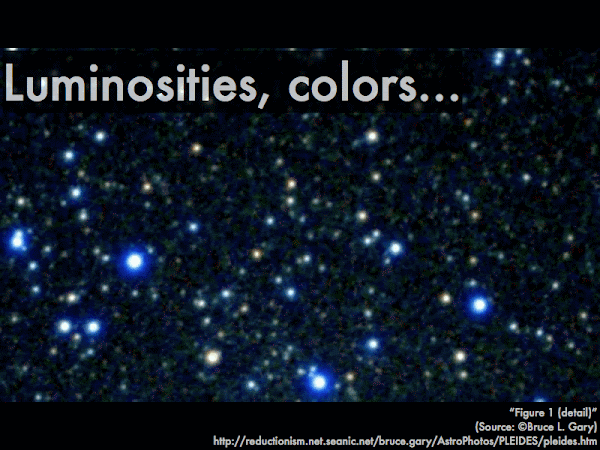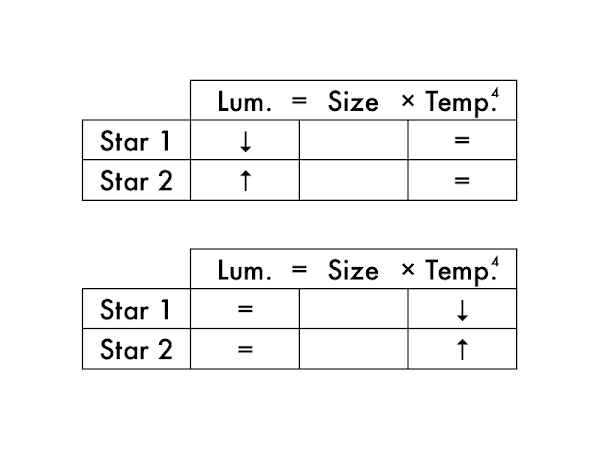Cuesta College, San Luis Obispo, CA
Students have a weekly online reading assignment (hosted by SurveyMonkey.com), where they answer questions based on reading their textbook, material covered in previous lectures, opinion questions, and/or asking (anonymous) questions or making (anonymous) comments. Full credit is given for completing the online reading assignment before next week's lecture, regardless if whether their answers are correct/incorrect. Selected results/questions/comments are addressed by the instructor at the start of the following lecture.
The following questions were asked on reading textbook chapters and previewing presentations on parallax, distance, apparent magnitude, absolute magnitude, Wien's law and the Stefan-Boltzmann law.

Selected/edited responses are given below.
Describe something you found interesting from the assigned textbook reading or presentation preview, and explain why this was personally interesting for you.
"How a dimmer star has a bigger positive magnitude number."
"Apparent and absolute magnitudes, because I felt that they were easy to understand."
"I always thought stars were all the same color."
"Blue is hot, red is cold for stars."
"That by gathering information like the color of the star and its luminosity you can accurately determine its size."
"Not much."
Describe something you found confusing from the assigned textbook reading or presentation preview, and explain why this was personally confusing for you.
"Not sure how the magnitude scale works in measuring the brightness of the stars."
"Small and large parallax angles--please explain how every six months we can tell the difference on stars' distances a little more clearer."
"The luminosity = size × temp4 charts, because there are no specific numerical values, just up/down arrows and equal signs, which is hard for me to grasp."
"I found everything confusing."
Explain how apparent magnitude and the absolute magnitude are defined differently.
"Apparent magnitude is the perceived magnitude of a star from Earth, and absolute magnitude is the definitive magnitude of a star."
"Apparent magnitude is the visual appearance from Earth and absolute magnitude is the apparent visual magnitude as if something would be 10 pc away."
"Apparent magnitude is based on how far away the star is whereas absolute magnitude is the actual magnitude of the star no matter its position."
"Apparent magnitude is solely from earth's perspective. Absolute magnitude levels the playing field by providing a fair way to compare brightnesses."
"Apparent magnitude is the observer's perspective of an objects brightness whereas, absolute magnitude compensates for the distance of an object, by using 'fair comparison distance' which is 10 parsecs."
"Not a clue."
Suppose the sun was moved to a distance of 10 parsecs away. As a result, its __________ magnitude would become dimmer.
absolute. [4] apparent. ************ [12] (Both of the above choices.) ** [2] (Neither of the above choices.) [0] (Unsure/guessing/lost/help!) * [2]

(Only correct responses shown.)
1 (brightest): the sun, m = –27 [75%]
2: Canopus, m = –1 [70%]
3: Vega, m = 0 [90%]
4 (dimmest): Kapteyn's star, m = +9 [85%]
Rank the brightnesses of these stars (1 = brightest, 4 = dimmest; there are no ties), if relocated to 10 parsecs from Earth.
(Only correct responses shown.)
1 (brightest): Canopus, M = –3 [70%]
2: Vega, M = +0.5 [60%]
3: the sun, M = +5 [65%]
4 (dimmest): Kapteyn's star, M = +11 [75%]
Determine whether these stars get dimmer or brighter when relocated from their original positions to 10 parsecs from Earth.
(Only correct responses shown.)
The sun: gets dimmer [90%]
Canopus: gets brighter [70%]
Vega: gets dimmer [50%]
Kapteyn's star: gets dimmer [55%]
Rank the temperatures of these main sequence stars (1 = hottest, 4 = coolest; there are no ties).
(Only correct responses shown.)
Hottest: blue main sequence star [80%]
Second hottest: white main sequence star [65%]
Third hottest: yellow main sequence star [85%]
Coolest: red main sequence star [80%]
Rank the temperatures of these supergiant and dwarf stars (1 = hottest, 4 = coolest; there are no ties).
(Only correct responses shown.)
Hottest: blue supergiant [75%]
Second hottest: white dwarf [55%]
Third hottest: yellow supergiant [65%]
Coolest: red dwarf [80%]

dimmer. *** [3] brighter. ************* [13] (These stars would be the same size.) ** [2] (Unsure/guessing/lost/help!) ** [2]
Two stars (equally far away) have the same brightness, but one star is cooler, and the other star is hotter. The __________ star will be larger in size.
cooler. ********** [10] hotter. **** [4] (These stars would be the same size.) **** [4] (Unsure/guessing/lost/help!) ** [2]
Ask the instructor an anonymous question, or make a comment. Selected questions/comments may be discussed in class.
"Will we be given numbers to fill in the boxes to compare stars using the Stephan-Boltzmann law?" (No specific numbers, but when you compare two stars at a time, you can always compare their luminosity, size, and temperature variables one-by-one.)
Still confused when it comes to ranking the stars' temperature." (We'll work on this.)
"Can you give us more examples on the whiteboards? Pleaseeee." (As you wish.)
"Are brightness and luminosity interchangeable?" (Yes, for our purposes, if you are referring to absolute magnitude and luminosity.)
"I had never really thought about the fact that stars cannot be any color of the rainbow but only a select few. I would like to find out more about why that is." (Go all the way back to Fig. 5-2 in Ch. 5, p. 78. The continuous spectrum of stars (ignoring the tiny absorption lines) has all the visible colors, but predominately red for warm stars, and predominately blue for super hot stars. For in-between hot stars, then you get an even mix of all the colors from blue through red, which our eyes perceive as white.)
No comments:
Post a Comment